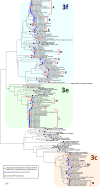HEV-3 subtypes and strains detected in cases of HEV infection in central Italy from 2015 to 2023
- PMID: 39254751
- PMCID: PMC11971221
- DOI: 10.1007/s15010-024-02348-0
HEV-3 subtypes and strains detected in cases of HEV infection in central Italy from 2015 to 2023
Abstract
Purpose: HEV is an emerging pathogen in Europe and was previously shown to be hyperendemic in areas of Abruzzo and Lazio, Central Italy. No systematic analysis of the HEV strains responsible for human infections over several years in Central Italy has previously been reported. Aim of the study was the molecular characterization of HEV from autochthonous hepatitis E cases occurred in Abruzzo and Lazio between 2015 and 2023.
Methods: Samples from 118 cases collected as part of virological surveillance in Abruzzo and Lazio from 2015 to 2023 were subjected to HEV sequencing and phylogenetic analysis.
Results: The main observed subtype was 3f, followed by 3c and 3e. The annual subtype distribution was quite stable over the observation period, but 3f cases tended to concentrate in winter/early spring whereas 3e cases in summer. Phylogenetic clusters of highly related sequences (a) highlighted unrecognized "point source outbreaks", (b) provided molecular support to temporally and/or geographically linked cases and (c) provided evidence for transmission of identical/highly related strains up to months/years following their first detection.
Conclusions: The data provide an overview of the HEV strains responsible for human infections over eight years in Central Italy. The observed subtype distribution appears to agree better with the subtype distribution reported in Italy in pigs rather than in geographically matched wild boars, suggesting pig and its derivate food was a more frequent source of infection than wild boar in Abruzzo and Lazio. Molecular characterization is essential to recognize "point source outbreaks" and to monitor HEV circulation.
Keywords: Foodborne diseases; Hepatitis E Virus; Phylogenetic analysis; Zoonoses.
© 2024. The Author(s).
Conflict of interest statement
Declarations. Ethical approval: This study was approved by INMI L Spallanzani Istituto di ricovero e cura a carattere scientifico (IRCCS) Hospital Ethics Committee (agreement 29/2013, approved on 05-21-2013). Competing interests: The authors declare no competing interests.
Figures




References
-
- Purdy MA, Drexler JF, Meng XJ, Norder H, Okamoto H, Van der Poel WHM, et al. ICTV Virus Taxonomy Profile: Hepeviridae 2022. J Gen Virol. 2022;103:001778. 10.1099/jgv.0.001778. - PubMed
-
- Si F, Widén F, Dong S, Li Z. Hepatitis E as a zoonosis. Adv Exp Med Biol. 2023;1417:49–58. 10.1007/978-981-99-1304-6_4.PMID. - PubMed
-
- EFSA BIOHAZ Panel (EFSA Panel on Biological Hazards), Ricci A, Allende A, Bolton D, Chemaly M, Davies R, Fernandez Escamez PS, Herman L, Koutsoumanis K, Lindqvist R, Nørrung B, Robertson L, Ru G, Sanaa M, Simmons M, Skandamis P, Snary E, Speybroeck N, Ter Kuile B, Threlfall J, Wahlstr€om H, Di Bartolo I, Johne R, Pavio N, Rutjes S, van der Poel W, Vasickova P, Hempen M, Messens W, Rizzi V, Latronico F, Girones R. 2017. Scientific Opinion on the public health risks associated with hepatitis E virus (HEV) as a food-borne pathogen. EFSA Journal 2017;15(7):4886, 89 pp. 10.2903/j.efsa.2017.4886. - PMC - PubMed
MeSH terms
Grants and funding
LinkOut - more resources
Full Text Sources

